The Women of Mariachi: Breaking Barriers in a Machismo Culture
This article originally appeared in She Shreds Magazine Issue #5, released June 2014.
Originating in Jalisco, Mexico via farm workers in rural areas, mariachi is now known as the music of Mexico. Much after its inception, these ensembles were brought to Plaza Garibaldi in Mexico City, where the now-established tradition of performing in restaurants began. Like most orchestras, these groups of musicians are created and led by a director who finds jobs and assigns music to the group. Wearing extravagant charro suits in a group of five or more, mariachis also perform during a celebration such as a wedding or a quinceñera, but can be heard almost anywhere: on the streets, at a political event, or even at a funeral. Mariachi is the music that celebrates life and death, love and heartache.
Rich in sound and passion, the machismo infiltrates this genre just like any other in a culture where gender roles are above ground. “You have to remember, women didn’t get the right to vote until 1953, so culturally they weren’t given the right to decide,” explains Dr. Leonor Perez, a mariachi herself and longtime researcher on women’s involvement in mariachi throughout history. “There was the first all-female group that we know of called Las Adelitas…within four years there were Estrellas De Mexico and Las Coronelas in 1953,” says Dr. Perez about the three pioneering groups who opened the door for many more to come.
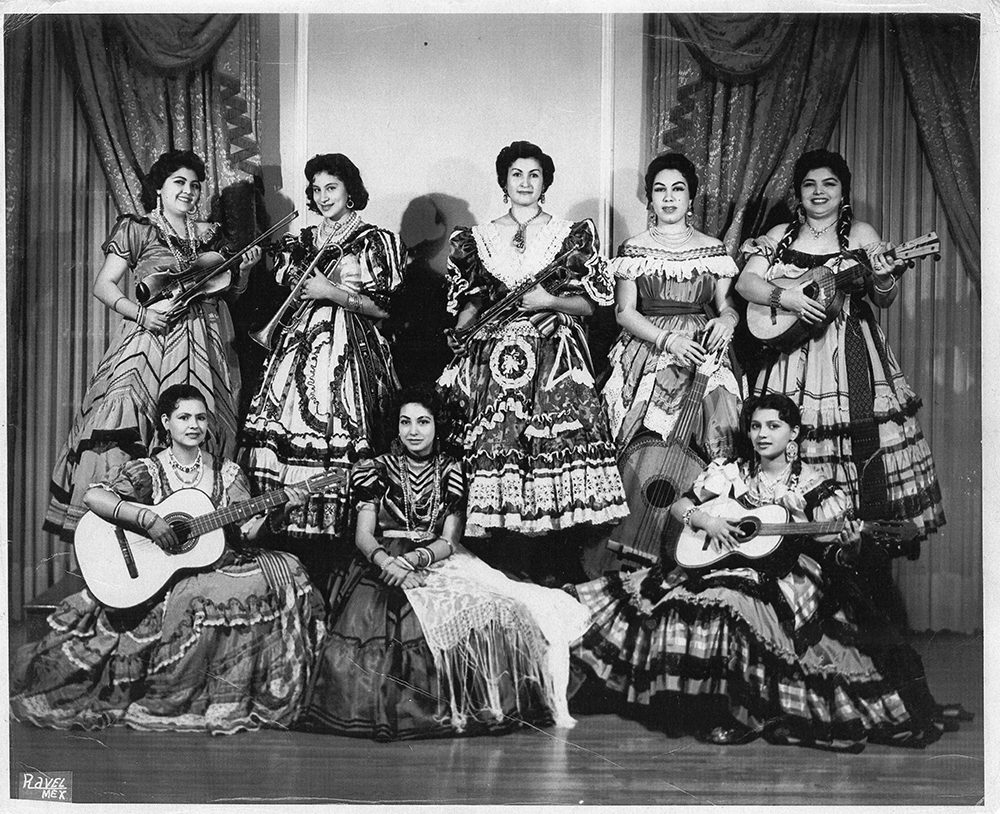
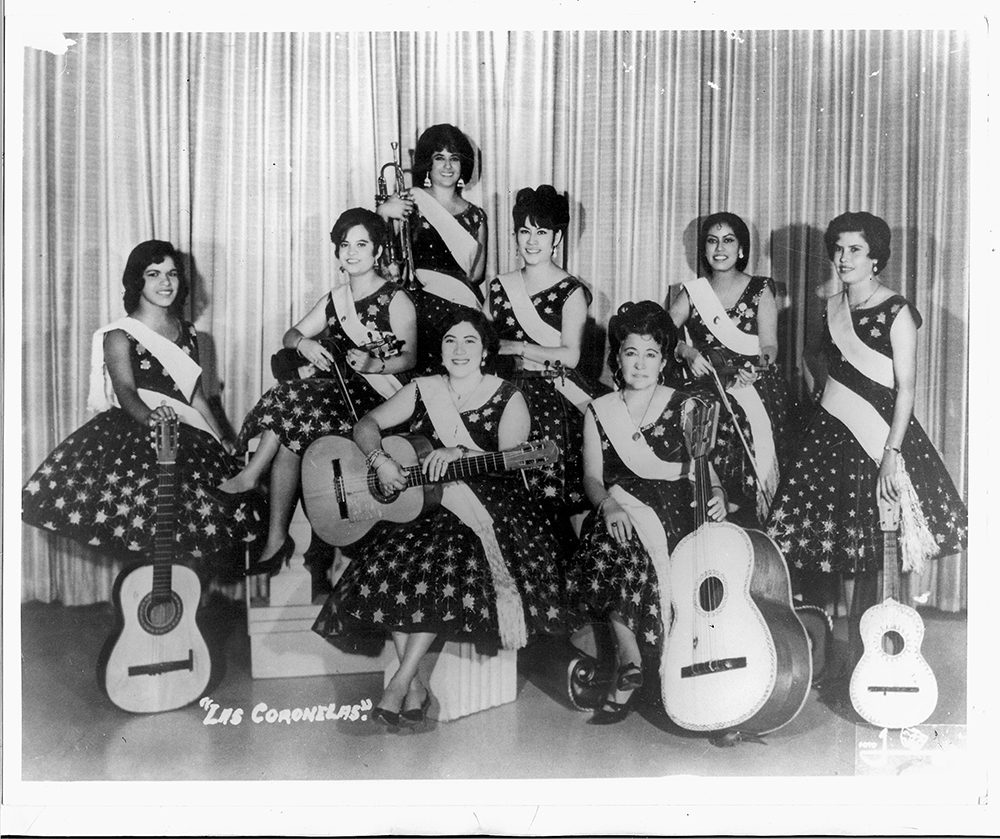
According to Perez, in recent years women’s presence in mariachi has become more common, and in 2014 there were about 30 all-female mariachi groups in the United States, 60 in Mexico, South America and Canada, and even one in England. Despite the barriers created by machismo, women all over the world are making headway as they continue to strive for presence and success in this evolving genre.
Although to many the female presence in mariachi culture is a new development, the timeline we’ve created below—with help from Perez—proves that women have been actively impacting the genre since the turn of the century. These mariachi groups continue to break barriers and spread the mariachi culture on international levels.
Timeline — Women in Mariachi:
1903 – Rosa Quirino is the first documented woman to play in a mariachi band.
1948 – First all-female mariachi band, Las Adelitas, from Mexico City formed after their director visited Cuba and saw an all-female tropical orchestra perform.
1951 – Second all-female mariachi band, Las Estrellas De Mexico, formed in Mexico City.
1953 – The third of the three pioneering all-female mariachi bands, Las Coronelas, formed in Mexico City.
1936–1969 – Golden age of Mexican Cinema. Movies such as Yo No Me Caso Compadre and Mi Niño, Mi Caballo y Yo showed these all-female mariachi bands performing in the background.
1967 – First all-female mariachi band in the United States, Las Rancheritas, forms in Alamo, TX.
1968 – Mariachi classes started being implemented in schools around California as part of bilingual and multicultural education, allowing mariachi to become an outlet for women to express their freedom and ethnic identity.
1975 – Renowned mariachi violinist Rebecca Gonzales breaks into the mainstream spotlight in the internationally renowned mariachi group Los Camperos de Nati Cano.
1976 – All-female mariachi band Las Generales forms in Los Angeles.
1977 – All-female mariachi band Mariachi Estrellas formed in Topeka, Kansas, as a church group.
1979 – The Tucson International Mariachi Conference is the first of its kind in the United States.
1991 – The Hollywood Bowl hosts a tribute to American women’s contributions to mariachi music over the decades
1994 – Mariachi Reyna De Los Angeles forms and becomes one of the most well-known mariachi groups in the United States. They celebrated 20 years in 2014.
2008 – Mariachi Mujer 2000 is chosen to represent all of the Americas at the 2008 Olympics in Beijing, China.
2009 – The Mariachi Divas become the first mariachi band ever to win a Grammy.
2013 – ¡Viva El Mariachi Femenil!, the exhibit curated by Leonor Xóchitl Perez, PhD, debuts at the Women’s Museum Of California, documenting 110 years of female presence in Mariachi music.
2014 – The Mariachi Divas become the first mariachi ever (men or women) to win a second Grammy.
2014 – Women Pioneers of Mariachi Music: Seen, Heard and Now Remembered, the first book exclusively dedicated to mariachi women is written and published by Dr. Leonor Xóchitl Perez.
2015 – Mariachi Arcoiris de Los Ángeles is L.A.’s first openly LGBTQ mariachi group and features the world’s first trans mariachi.

You May Also Like
No related posts
No related posts
More posts
-
By: Cynthia Schemmer
-
By: She Shreds
-
By: She Shreds
-
By: She Shreds
-
By: She Shreds
-
By: She Shreds
-
By: She Shreds
-
By: She Shreds
-
By: She Shreds
-
By: Cynthia Schemmer
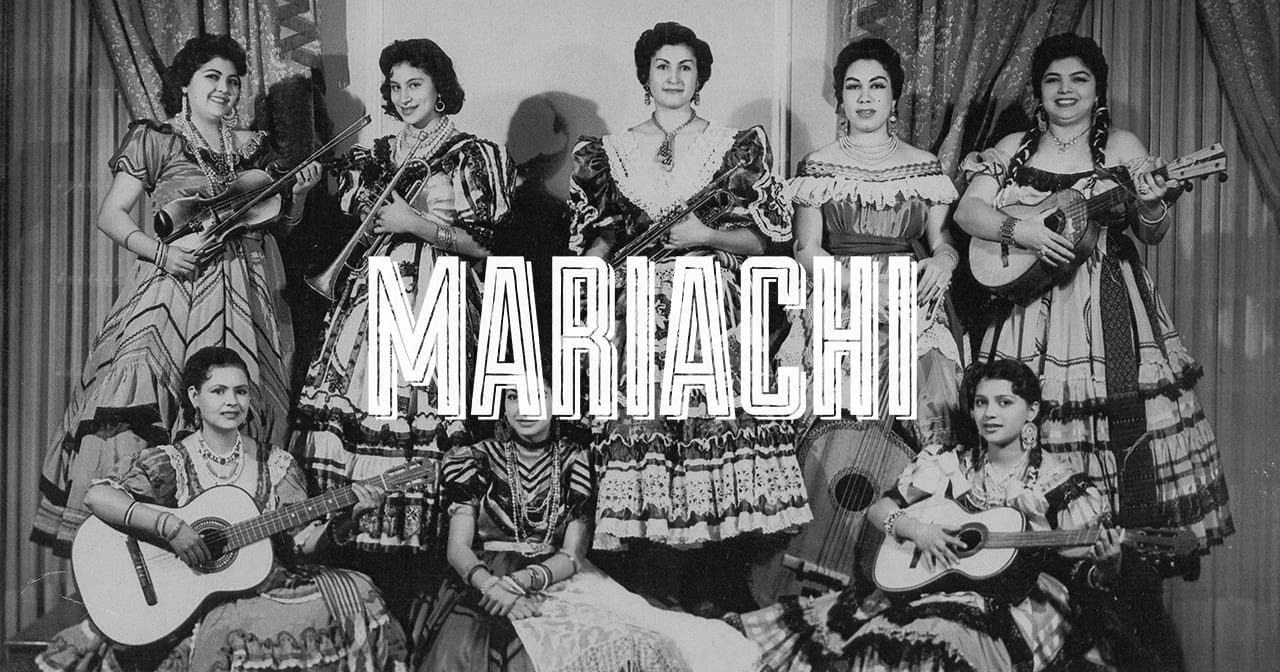
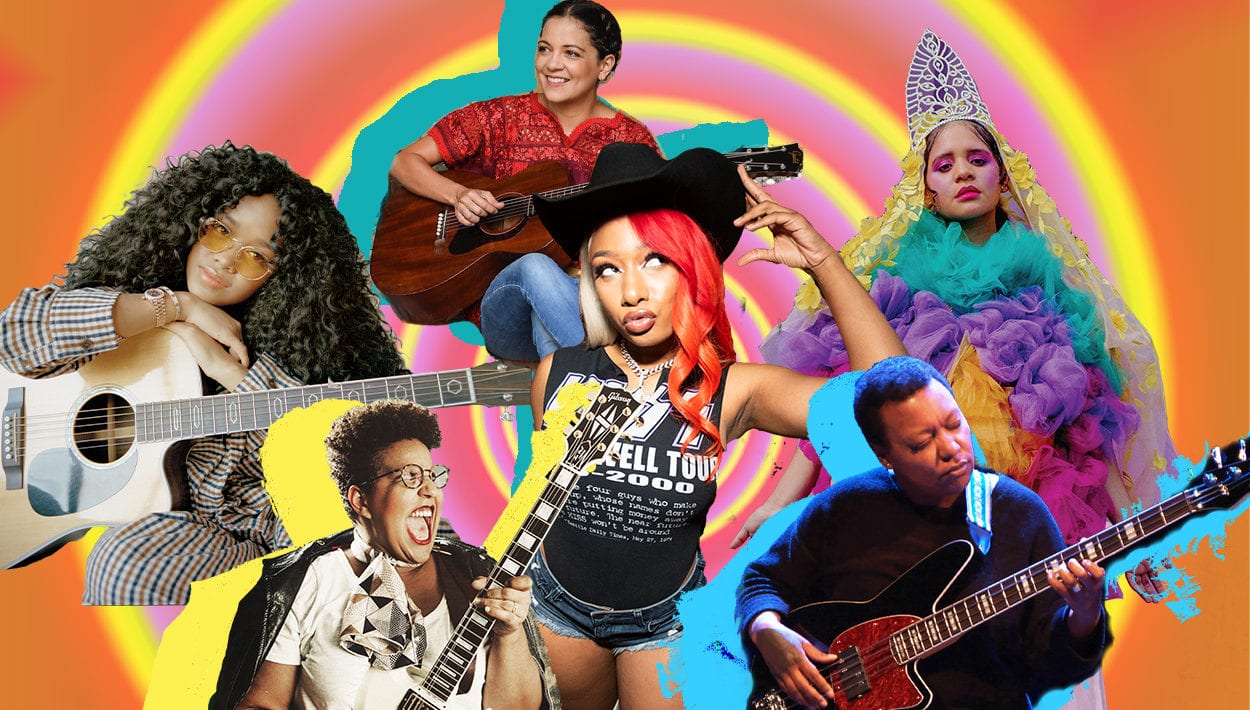


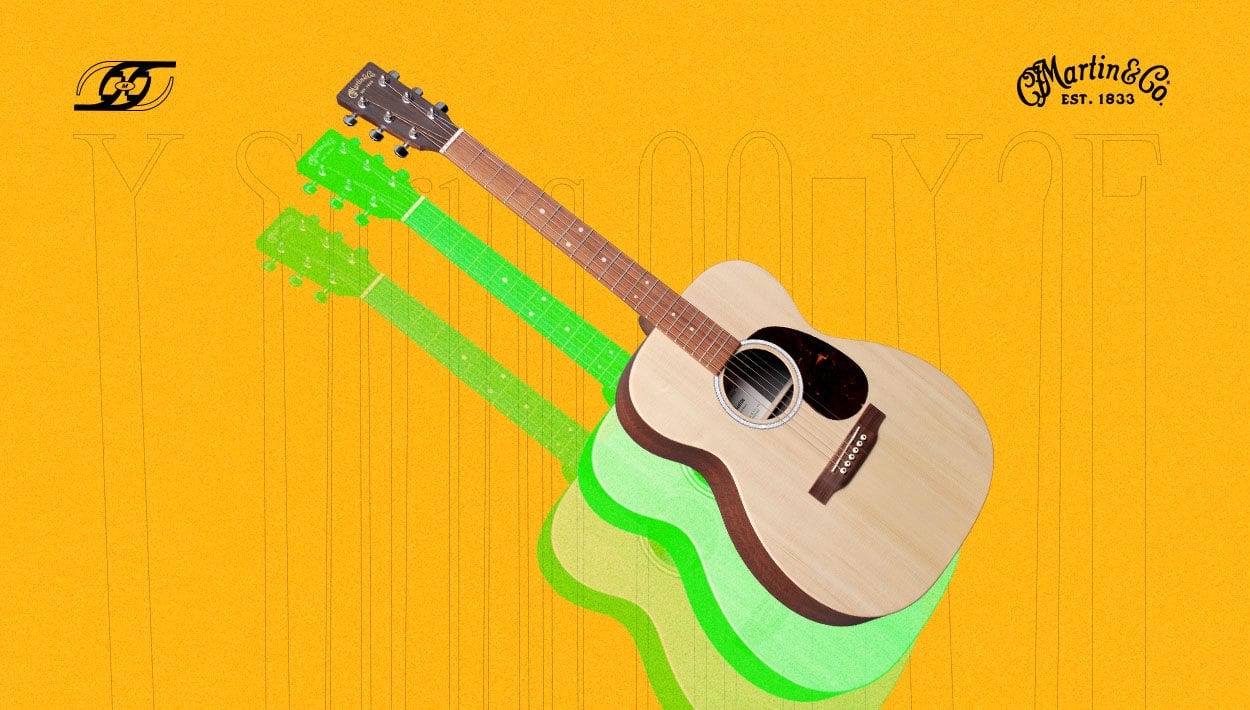


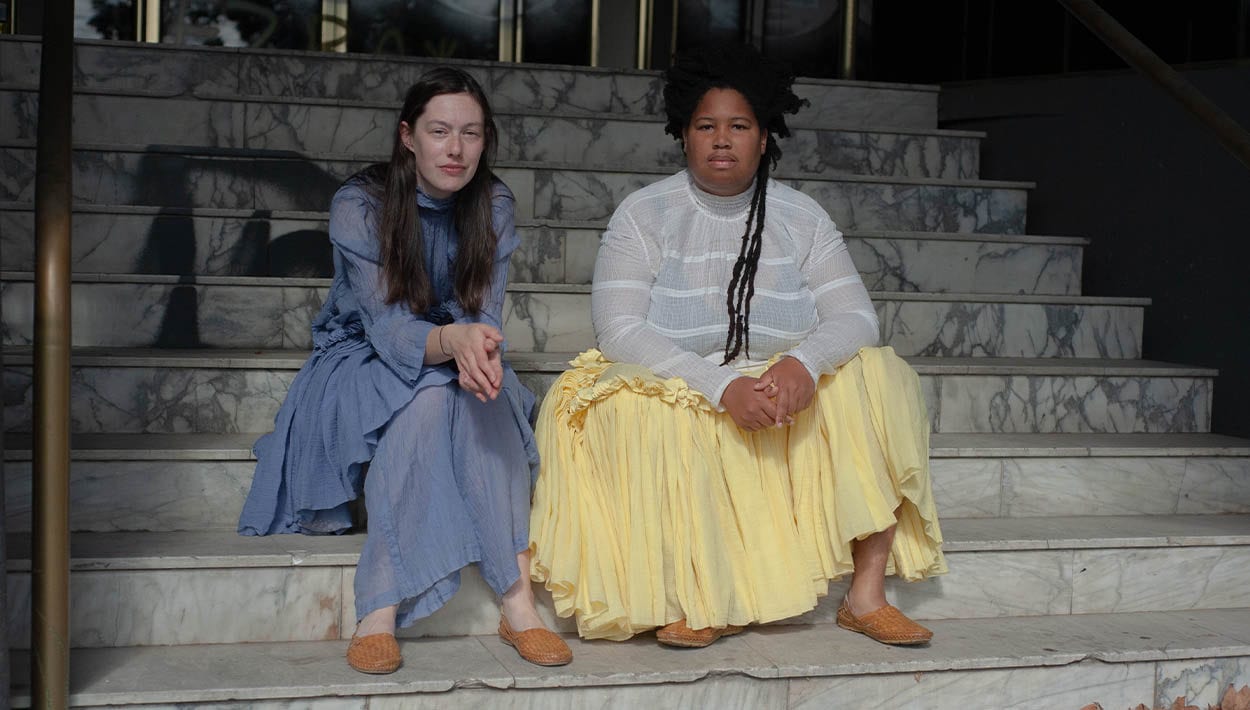
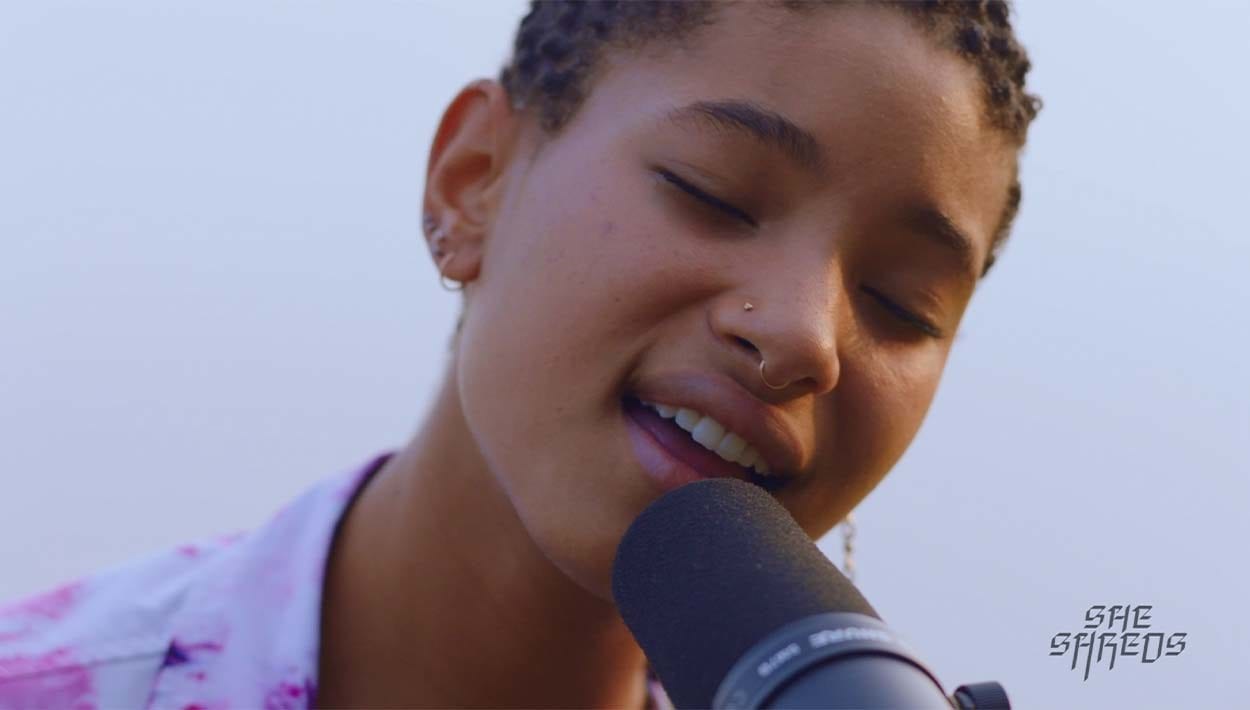
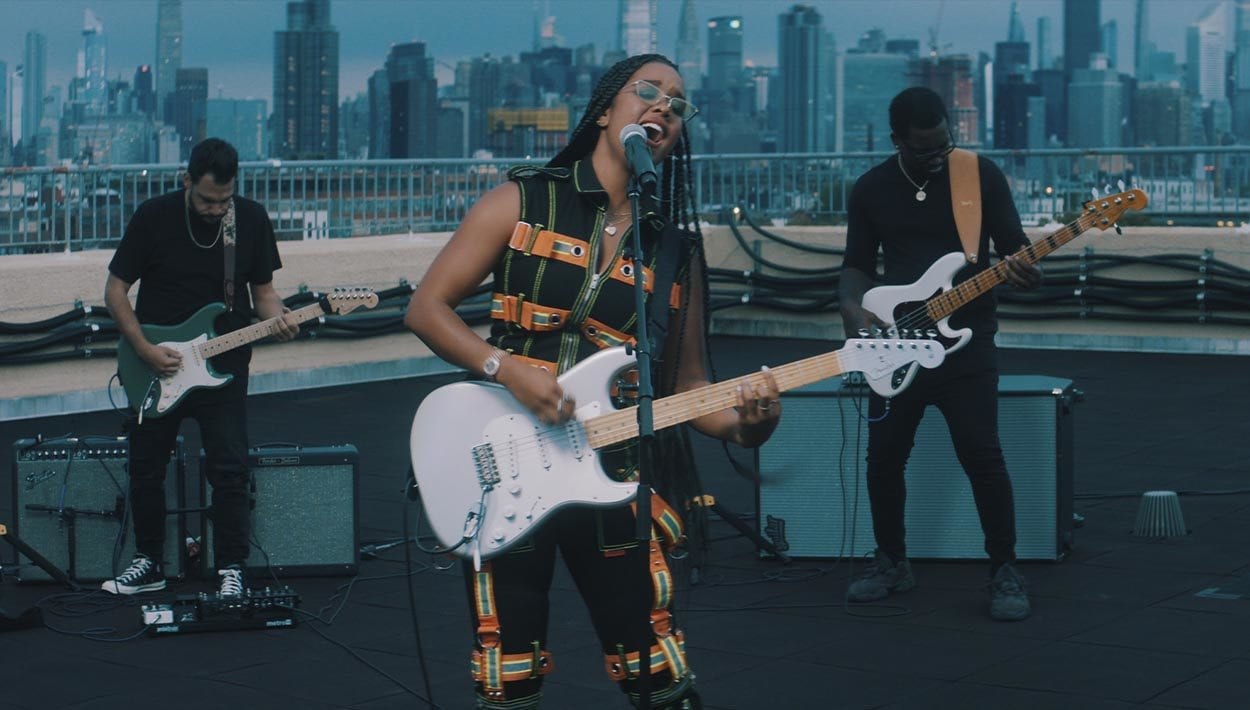



Comments
[…] just launched a new website, online music tutorials by women and articles on everything from women in mariachi music to St Vincent’s guitar designs for women’s […]
Pingback by She Shreds: guitar magazine empowers women to rip up stereotypes on September 25, 2015 at 9:27 am[…] just launched a new website, online music tutorials by women and articles on everything from women in mariachi music to St Vincent’s guitar designs for women’s […]
Pingback by She Shreds: guitar magazine empowers women to rip up stereotypes – The Guardian | Music instruments market on September 25, 2015 at 10:22 amA Ph.D. Dissertation about women in mariachi music.
https://www.academia.edu/17269647/Soto_Flores_Leticia_Isabel_-_How_Musical_is_Woman_Performing_Gender_in_Mariachi_Music
Comment by Women in Mariachi on November 19, 2015 at 12:24 pmThe first mariachi conference was in San Antonio in 1979 not Tucson.
Comment by Cynthia Munoz on May 23, 2016 at 7:03 pmThere have never been many restaurants, per se, in Plaza Garibaldi. The first groups to be brought there played in the Salón Tenampa–a cantina–and the majority of groups in that plaza have always performed freelance in the open air, without being associated with any business or establishment. While historically there are a handful of cases of mariachis being “created and led by a director who finds jobs and assigns music to the group,” 99.9% of mariachis were not formed that manner.
Comment by Jonathan Clark on May 23, 2016 at 10:20 pmNo comment on some big misinformation.
Comment by Jose Hernandez on May 23, 2016 at 11:16 pmI’m sure in not intentional.
Thank you so much for this. I was in https://tracktrace.one/usps/ to this issue and tired to tinker around to check if its possible but couldnt get it done. Now that i have seen the way you did it, thanks guys
Comment by edasmith Smith on February 15, 2020 at 3:26 amwith
regards
[…] feminine mariachis have existed in some capability for over a century, there’s one thing significantly particular about Mariachi Femenil’s method to the artwork […]
Pingback by Begin a Revolutionary Mariachi Band: A Step-by-Step Information | GREAT NEWS on July 9, 2020 at 9:19 am[…] female mariachis have existed in some capacity for over a century, there’s something particularly special about Mariachi Femenil’s approach to the art form. For […]
Pingback by How to Start a Revolutionary Mariachi Band: A Step-by-Step Guide – Top Fashion Skills on July 9, 2020 at 5:39 pm[…] female mariachis have existed in some capacity for over a century, there’s something particularly special about Mariachi Femenil’s approach to the art form. For […]
Pingback by How to Start a Revolutionary Mariachi Band: A Step-by-Step Guide | TechMAQ | Be Fast, Be Forward on July 9, 2020 at 10:39 pm[…] feminine mariachis have existed in some capability for over a century, there’s one thing significantly particular about Mariachi Femenil’s method to the artwork […]
Pingback by How to Start a Revolutionary Mariachi Band: A Step-by-Step Guide - MHN Pakistan on July 10, 2020 at 3:40 am[…] forgotten women artists alongside profiles of under-recognized women artists. (Take, for example, She Shreds’ feminist reprise of mariachi culture, or their dressing-down of guitar lore with an important and long-overdue nod to black women […]
Pingback by She-Horse: Lessons in the Dangers of Brand Politics from the Perennial 'Women-in-Music' - Kela Parker on September 28, 2020 at 7:35 pm[…] 1903, Rosa Quirino became the first recorded woman to play in a mariachi band. This was a huge deal for the all-male ?? music […]
Pingback by These Latinas are shattering our machismo culture - Pulso on April 27, 2021 at 11:06 amthanks for this it is useful for me.
Comment by James Beatirx on September 26, 2021 at 10:58 pmmariachi band. Old is gold.
Comment by JW Hawk on September 27, 2021 at 5:53 amvery useful
Comment by abigail on November 23, 2021 at 8:40 pmThis is exactly what I’ve been looking for! squidgaming
Comment by squidgaming on November 30, 2021 at 8:04 pmHello, thank you for sharing your article with us, and I truly value your information, which I really appreciate, and I would visit your website again.Aviator Jacket
Comment by Aviator jacket on December 1, 2021 at 9:54 pmYou provided accurate and useful information in your post. Thanks. I’m glad you shared this information. SEO services in Stafford
Comment by Isidore on January 2, 2022 at 6:27 amHi, thank you for sharing your article with us. I really appreciate the information you shared, and I would return to your website. Lost Audi key London
Comment by Patrick on January 3, 2022 at 4:04 amHello, thank you for sharing your article with us. I really appreciate your information, and I will definitely be returning to your website. Locksmith Todpuddle Street
Comment by Kendall on January 8, 2022 at 4:56 amHey there, this is Roy. I really want to appreciate your work. I really like the information that you have given all the users. I would definitely recommend your website to my friends who are also running their website which is regarding German job seeker visa. This will help them a lot in understanding blog posts.
Comment by Roy359 on February 9, 2022 at 2:09 amYour articles are very interesting, thanks for writing them. It is a pleasure to read your blog. I enjoy it. Basically you are what I am looking for. This blog provides me with a lot of useful information. It will be a pleasure to read more from you. Rolls Royce chauffeur
Comment by Randolph on March 3, 2022 at 5:07 amAmazing! old is always remains gold. thanks for this.Yellowstone Rip Wheeler Jacket
Comment by Lance Rock on March 15, 2022 at 6:43 amAmerica Suits, a trusted name and a leading company in the fashion industry, We have satisfied over 60000 customers in the last 10 years and we are keep growing, selena hosting leather coat America suits designs are based on celebrity fashion motivation and one of our biggest super hit jackets includes the Blade Runner coat and Top Gun 2 Jacket motivated by the movies, We have great inspirational jackets from the Best Hollywood Celebrities like Jennifer Lopez and lady gaga
Comment by Davit Jack on July 12, 2022 at 8:10 amI am a huge fan of music and love to know about its history. Thanks for this great article really appreciate your work. Nowadays I prefer listening music while playing my favorite game Super Sus MOD APK and also while walking.
Comment by Lisa on July 22, 2022 at 9:18 amThanks for the nice blog.
Comment by Juice Wrld Vest on September 24, 2022 at 4:48 amShop this best quality Killing Eve Yellow Jodie Comer Coat For women SHOP NOW….
Comment by Alexandra alegria on October 5, 2022 at 2:03 amI am truly delighted in perusing your article. I discovered this as an educational and fascinating post, so I think it is exceptionally valuable and proficient.Michelle obama sergio hudson coat
Comment by markwillson on October 27, 2022 at 1:17 amThese women have to deal with fascinating comments from fans as well as discrimination from men in their industry. Do my online course.
Comment by Maxwell Lord on November 28, 2022 at 11:14 pmI really want to appreciate your work. I really like the information that you have given all the users. I would definitely recommend your website to my friends who are also running their website which is regarding German job seeker visa.
Comment by jamessbuzzz on December 3, 2022 at 2:04 amThis posting contains a number of intriguing points across time, but I\\\’m not sure I see each one in its entirety. There is undoubtedly some truth to it, but I will reserve judgment until do my assignment for me I have done further research. Thank you for a great essay; we now want to read more!
Comment by jessicaalex on December 7, 2022 at 3:28 amvery nice post, i undoubtedly adore this excellent website, carry on it ryan reynolds outfit spirited
Comment by Alex on December 28, 2022 at 2:30 amThere’s really nothing to dislike about this game, it’s made to perfection Donkey Kong
Comment by Emma on January 13, 2023 at 12:08 amThanks for sharing this amazing and informative post. keep sharing with us.
Comment by Jacket Hunt on January 17, 2023 at 10:35 pmAmerican leather jacket
The book delves into the personal stories of female mariachi musicians and their journey to break through the barriers of machismo culture. As a bonus, you can use our hey dude shoes usa coupon code for discounts on stylish and comfortable shoes while reading the book!
Comment by Kevin Peterson on January 28, 2023 at 11:11 amThe whole post is totally creative. I have learned many more things from the post. We are offering assignment help for university students with online tutoring. Our expert has experience in solving assignment of for writing this type of article..
Comment by Sam on February 3, 2023 at 2:49 amDatabase Management assignment help . Our expert professional help to score good grade in university coursework exam. All the assignment which has solved is totally plagiarism free contents.
The whole post is totally creative. I have learned many more things from the post. We are offering assignment help for university students with online tutoring. Our expert has experience in solving assignment of for writing this type of article..
Comment by Sam on February 3, 2023 at 2:49 amDatabase Management assignment help . Our expert professional help to score good grade in university coursework exam. All the assignment which has solved is totally plagiarism free contents.
your post is great
Comment by medital on February 4, 2023 at 6:17 pmlove the content of this blog and the positive intent you have. Thanks!
Comment by Jacket Hunt on February 14, 2023 at 2:00 amStudded Biker Jacket
Nice post. Thanks for sharing, keep it up…visit for more
Comment by Sid on February 14, 2023 at 6:24 amvery informative post nie article check now leather jacket and bags
Comment by uzair on February 21, 2023 at 11:59 pmvery informative post nie article check now: leather jackets and bags
Comment by rehman on February 22, 2023 at 12:03 amGreat post, I really liked it. Great respect for the author. It is very interesting. Website Maintenance Dubai
Comment by si3 digital on February 25, 2023 at 3:48 amExcellent post; I truly enjoyed it. Huge admiration for the author. It’s quite fascinating.
Comment by Jack on March 6, 2023 at 5:40 amYour blog provided us with valuable information. I am looking forward to read more blog posts from here keep it up!! Snow Beach Jacket Raekwon
Comment by Mike Rooney on April 28, 2023 at 11:56 pmOrganizations and initiatives that promote gender equality and empower women can also be instrumental in breaking down barriers. These can include mentorship programs, leadership development, and advocacy for women’s rights. It is also important to ensure that policies and laws support gender equality and that they are enforced effectively.
Breaking down barriers in a machismo culture is a challenging but necessary task. By working together and challenging traditional gender norms, we can create a more equitable and inclusive society for all.
Further Information: top gun bomber jacket
Comment by Steave James on May 10, 2023 at 9:00 pmThe styling tips provided are sure to take any skill to the next level. Kudos to the author for a fantastic piece! . A red leather jacket exudes confidence and individuality, making it a favorite among fashion enthusiasts. Whether you wear it with black skinny jeans and ankle boots or pair it with a little black dress for a night out, the red leather jacket is guaranteed to turn heads.
Comment by John Albert on May 16, 2023 at 11:52 pmI am really glad to see this kind of wondrous blog, its quite helpful and having amazing ideas.
Comment by Medals on May 18, 2023 at 8:49 amWow, this article beautifully highlights the inspiring journey of the women of Mariachi, breaking barriers in a machismo culture. Their talent and dedication are truly commendable. By the way, I couldn’t help but notice the captivating style of their attire, reminiscent of Walter White Jacket. Truly a powerful combination of music and fashion
Comment by Peter Parker on May 24, 2023 at 3:39 amCmolds is a leading iOS mobile app development company, specializing in creating innovative and high-quality mobile applications. Their expert team of developers is dedicated to delivering customized solutions that meet the unique needs of businesses and users alike. Trust Cmolds to bring your app ideas to life with their top-notch iOS development services.
Comment by Cmolds Molding Creativity on May 26, 2023 at 3:18 pmCan I say it is such a relief to discover somebody who truly knows what theyre preaching online? You actually have learned to bring a problem to light and make it crucial. Eileen 2023 Rebecca Red Blazer More people should see this and can see this side of the story. I cant believe youre no more well-known simply because you definitely contain the gift.
Comment by nancystark on May 30, 2023 at 5:01 amCan I say it is such a relief to discover somebody who truly knows what theyre preaching online? You actually have learned to bring a problem to light and make it crucial.
Comment by buy coke on June 25, 2023 at 8:33 amI am really love to read such most amazing kind of blog post, its really beneficial and helpful for me.
Comment by Web Design Company on June 27, 2023 at 8:11 amNice topic
Comment by skywassranch on June 27, 2023 at 9:51 amThanks for sharing this information. If You want to compare Term Insurance plans online then you must visit Okbima’s official website.
Comment by Okbima on July 12, 2023 at 10:24 pmLooking to buy cocaine online? We’re top supplier of cocaine with over 97% purity levels.
Comment by Buy cocaine Onlien on July 31, 2023 at 3:29 amLooking for fast and professional online assignment services uk? Choose Rapid Assignment Help and enjoy high-quality assignment assistance at low rates. Get customized solutions, timely delivery, and excellent grades. Don’t let assignments stress you out, get the support you deserve today.
Comment by Assignment Services UK on August 2, 2023 at 11:05 pmI thoroughly enjoy reading such incredibly amazing blog posts. They provide immense benefits and are extremely helpful to me.
Comment by TJ Handyman on August 4, 2023 at 5:57 amMy recent purchase of a contemporary fridge with all the bells and whistles has been a game changer. The movable shelves and compartments make organisation a snap, and the built-in ice and water dispenser adds a luxurious touch to my kitchen. It’s not simply utilitarian; it’s also a fashionable addition to my house!
Comment by Alex on August 8, 2023 at 11:55 pmWelcome to SMM Panel One, the one-stop solution for all your social media marketing needs. With our cutting-edge SMM Panel, you can effortlessly elevate your online presence and reach new heights of success. From increasing followers, likes, and engagement to managing multiple platforms in one place, our user-friendly interface empowers you to stay ahead of the competition. Maximize your brand’s impact and visibility with our comprehensive suite of services and analytics. Join SMM Panel One today and witness the power of social media marketing at its finest.
Comment by SMM Panel One on August 9, 2023 at 12:52 amI read a lot of interesting things from it. Thank you very much for sharing. Hope you will update more news in the future.
Comment by brezzsent on August 17, 2023 at 3:55 amI highly value the knowledge you’ve shared, and I appreciate the time and effort invested in your website. Your comprehensive information has been an asset. The team at Universal Motors specializes in sourcing used vehicles globally at competitive prices, ensuring meticulous care in their export process.
Comment by Universal Motors on August 24, 2023 at 1:09 amAmazing article you have shared with use thanks for sharing.
Comment by PUBG Mobile Lite on August 24, 2023 at 10:17 pmBuy cheap quality cocaine online with discreet overnight and doorstep delivery
Comment by smith murphy on August 27, 2023 at 4:37 pmWhat a comprehensive and enlightening journey through the rich history of women in mariachi culture! Your timeline beautifully captures the evolution and contributions of women in this genre, from its earliest days to the present. It’s heartening to see how women have continuously broken barriers and enriched the mariachi landscape with their talent and determination. Your dedication to shedding light on these trailblazing women is truly commendable.
Comment by Marryjohn on August 30, 2023 at 4:11 amFrom minimalistic to bold, GalleryDept has a hoodie for every mood and occasion.
Comment by gallerydeptofficial on September 5, 2023 at 4:34 amFrom moderate to striking, GalleryDept has a hoodie for each temperament and event.
Comment by gallerydeptofficial on September 5, 2023 at 4:39 amThe Women of Mariachi: Breaking Barriers in a Machismo Culture,’ and it was incredibly inspiring! This article beautifully showcases the talent, resilience, and determination of these amazing women who are breaking down barriers and shattering stereotypes in the world of mariachi. Their passion for music and their commitment to pursuing their dreams despite societal challenges is truly commendable. I’m so glad this film is shedding light on their remarkable journeys. Kudos to the filmmakers for sharing such an important and empowering story!”
Comment by Bruce Wyne on September 7, 2023 at 3:08 amawesome article thanks for posting this informative article.
Comment by kashi digital on September 12, 2023 at 6:13 amawesome for this post. Website Design In Varanasi
Comment by kashi digital on September 13, 2023 at 4:42 amGreat post Website Design In Varanasi
Comment by ngo in varanasi on September 13, 2023 at 4:43 amInformative blog, thank you.
Comment by shopsneakers on September 18, 2023 at 4:35 amOrder cheap quality cocaine online with discreet overnight and doorstep delivery
Comment by smith on September 20, 2023 at 8:24 pmInteresting blog, so informative.
Comment by virginityrockshoodies on September 25, 2023 at 3:54 amUsually, I don’t comment on the blogs but your way of article writing forced me to comment today. This is a very nice and informative article. I hope your blog grows like pubg mobile lite one of the best games that are growing day by day.
Comment by pubg lite on September 28, 2023 at 12:48 amGreat app fo videos.
Comment by loklokapp on October 6, 2023 at 10:02 pmThere are different kinds of yoga, so anyone can find a type that suits them. Yoga is very beneficial for the mind and body because it improves strength, flexibility, and posture. Although there are many types of Yoga, they all work to help reduce stress and anxiety. Yoga is a great way to improve your flexibility, strength, and balance. It can also help you relax and de-stress.
Comment by health inpedia on October 7, 2023 at 3:24 amOfficial Store
Comment by tylerthecreator on October 10, 2023 at 11:47 pmJordan hoodies are more than just clothing; they’re a lifestyle. With their unbeatable comfort and iconic design, they represent a commitment to excellence in both sports and fashion. When I wear my Jordan hoodie, I feel like I’m part of a winning team!
Comment by jordanhoodies on October 16, 2023 at 2:02 amhttps://loklokapp.co/
Comment by loklok on October 20, 2023 at 2:36 amThank you for ur post
Comment by Shams on November 5, 2023 at 9:50 amYour post is like a breath of fresh air in the vast social media landscape! The thoughtful content and captivating imagery truly make it stand out. Keep spreading the positivity and creativity – you’re making a difference one post at a time!
Comment by Top 5 Hindi on November 17, 2023 at 7:38 pmFakaza Mp3 Download, Latest 2023 Fakaza Music Amapiano Songs oF South African, Sa Hip Hop, GQom, Kwaito, Tribal & Afro House. We provide you with the greatest and most fascinating sa music download at all times. You may search for the top South African Amapiano Music artists and download or listen to tracks in the highest possible quality immediately from your smartphone or computer.
Comment by Fakaza on November 19, 2023 at 8:38 amhttps://revengehoodie.co/
Comment by revengehoodie on November 24, 2023 at 4:52 amIts really nice, Great Article Appreciated
Comment by Rainbow water on November 29, 2023 at 2:43 am
Pergola Design is a leading pergola company in Dubai, offering durable and stylish pergola in the market. Our Wooden Pergola are made of meranti wood from Malaysia, and we use the best quality paint with stain and varnish for the wood protection.
Comment by Wooden Pergola on December 4, 2023 at 5:18 amFor sports betting, you can consider the reliable and user-friendly Melbet app https://livepda.ru/2800-melbet-na-android.html The Melbet betting company has been working in the profile market for several years and provides services officially, which is confirmed by an international license. The company pays the prize money on time, constantly upgrades and updates the software
Comment by djambo on December 10, 2023 at 10:28 amLet’s delve into the details of why ryan gosling jacket in blade runner became an iconic fashion statement.
Comment by EliteJacket on December 11, 2023 at 2:26 amI want to always read your blogs. I love them
Comment by brokenplanet on December 18, 2023 at 1:11 amIn every strum of the guitar and every resonating note, these women echo the sentiment that LifeChoices are the threads that weave the tapestry of a fulfilling existence. Join the chorus of celebration and empowerment as we honor The Women of Mariachi and their extraordinary journey of breaking barriers, one LifeChoice at a time.
Comment by LifeChoice on December 19, 2023 at 12:22 amvery nice post
Comment by umartalat on December 21, 2023 at 4:34 amI want to always read your blogs
Comment by Hernandez on December 30, 2023 at 3:34 amOne such iconic garment that effortlessly blends rugged charm with contemporary flair is the men’s distressed leather jacket. What makes these jackets a perennial favorite, and why should every man consider adding one to his wardrobe?
Comment by EliteJacket on January 8, 2024 at 2:53 amThankful for stumbling upon this informative post on send luggage to usa! Sending packages across borders can be a bit overwhelming, but your insights have truly been a game-changer. The tips and recommendations provided here are invaluable for anyone looking to ensure a smooth and reliable delivery process. Much appreciated for sharing this knowledge and making international shipping seem a lot more manageable!”
Comment by markas223 on January 9, 2024 at 9:05 amI will share it with my other friends as the information is really very useful. Keep sharing your excellent work. solplanet inverter distributor
Comment by Solplanet Inverter on January 10, 2024 at 2:41 amRevenge Official Clothing · Revenge Multi Bunny Arch Logo Hoodie. Quick View · Revenge Web Bunny Tee. Quick View · Revenge All Girls Are The Same Hoodie. Quick …
Comment by Revenge Clothing on January 14, 2024 at 7:28 amCaptivated by the sheer elegance of this post! 🌟 Your creativity knows no bounds, and the way you’ve blended colors and concepts is truly a feast for the eyes. 🎨👁️🗨️ Every element seems to dance with a harmonious rhythm, creating a visual symphony that’s both enchanting and thought-provoking. 🎶✨ Bravo on such a masterpiece!
Comment by Egg Price on January 21, 2024 at 11:17 pmwe have it all
Comment by henry on January 28, 2024 at 1:18 amThank you so much for this information.
Comment by Ajker Porbo on February 1, 2024 at 9:21 pmThis is amazing post you shared with us and i recommend to my friend to read this content.
Comment by Threads sky on February 5, 2024 at 3:48 amWe provide assistance with Arlo account login, guiding you through the process. Access our support for step-by-step instructions, ensuring seamless entry to your Arlo account. Rely on us for effective solutions and enhanced security.
Comment by arlo account login on February 23, 2024 at 2:15 amGallery dept takes center stage in the fashion world, effortlessly merging streetwear with high-end aesthetics to enthrall enthusiasts globally.
Comment by Gallery Dept on February 27, 2024 at 2:59 amWhile exploring your blog, I unexpectedly discovered a delightful revelation. Your prose instantly captured my attention, enticing me with its irresistible charm and profound wisdom from the very beginning. Your expressions inspire introspection and kindle a journey of self-exploration. If you’re interested in reading more blogs like this, I highly recommend visit assessment help. It has a wide variety of informative and insightful articles on a variety of topics.
Comment by Jasmine on February 28, 2024 at 5:12 am